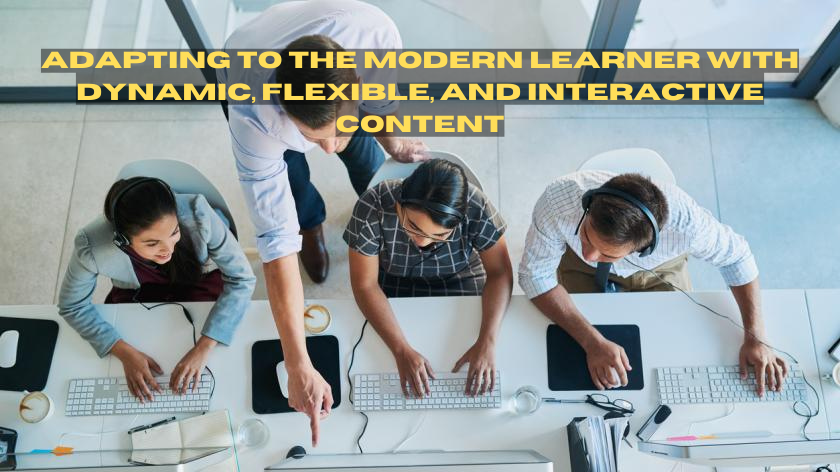Adapting to the Modern Learner with Dynamic, Flexible, and Interactive Content
The learners you target with your e-learning courses and other training materials experience learning in a very different way to experiences of 20 years ago. Today, learning is democratised as anyone can search for any topic and will find a plethora of training materials, from YouTube videos to blogs to step-by-step guides.
How can you ensure your training strategy and the courses and materials you create appeal to the modern learner? How can you adapt your approach and the content you produce to engage with modern learners and ensure your organisation has the skills it needs to remain competitive, compliant, and resilient?
The following 12 tips will help you adapt training in your organisation to the modern learner.
Microlearning Modules
Break down your training content into short, focused segments. E-learning is the ideal delivery method for this type of training.
Microlearning modules mirror the bite-sized style of learning that is common on platforms like YouTube, TikTok, and Instagram. Short bursts are more digestible, they suit short attention spans, and they can help with knowledge retention as they prevent information overload.
Interactive Content
It is essential to engage modern learners by integrating interactive elements into your training content. The days of passive learning are over, even for dull and functional topics. Modern learners need to be involved in the course through features such as quizzes, polls, drag-and-drop exercises, and simulations.
Again, interactive content mirrors the experience of familiar digital platforms that modern learners use on a daily basis.
Adaptive Learning Paths
One of the biggest features of the democratised learning experience is that learners can control their own path. For example, they might search for a topic and find a relevant YouTube video, but they might skip through the first 90 seconds because they already understand that part of the process.
Therefore, it is beneficial to provide personalised learning experiences. This can include allowing learners to choose their own learning paths based on current knowledge and skills, and/or interests and learning goals.
Social Learning Integration
Modern learners are familiar with using social media for a range of purposes, including acquiring new knowledge and learning new skills. This makes it beneficial to create social collaboration and peer learning opportunities that integrate social media principles and/or platforms.
For example, you could integrate a discussion forum in an e-learning course or include collaborative projects. Peer review systems are another possibility. The idea is to recreate the social nature of platforms like Facebook and TikTok within the e-learning environment.
Mobile Optimisation
Training content, especially e-learning content, must always be mobile-friendly to ensure it works on the devices that learners want to use.
Use Multimedia
YouTube has been mentioned several times already in this blog, highlighting the importance of videos to the modern learner.
It isn’t just videos, though, as other multimedia content is also important. Infographics, charts, and animations are all examples.
Gamification
Gamification elements can help keep modern learners who are familiar with playing online games engaged with your training courses and content. For example, you could implement a scoring system or another mechanism that encourages competition between learners. Another example is offering learners badges or similar rewards based on achievements and the completion of milestones.
Feedback Mechanisms
Modern learners like to have a clear understanding of their progress, so it helps to include feedback mechanisms. One of the most common options is a quiz, although quizzes are often included in training materials such as e-learning courses as a way of testing knowledge. It is important to test knowledge, but it is also helpful to provide feedback to learners, making quizzes an important training tool.
Continuous Updates
A quick way to turn off modern learners is to present them with outdated or inaccurate information in training courses. With digital methods of delivering training, such as e-learning, it is easier than ever to keep training materials accurate and up to date.
Therefore, all training content should be regularly updated, just as blogs and social media are constantly updated with fresh content.
User-Generated Content
One of the main features of modern learning is much of the content that is available is user generated. In other words, supercharged peer learning.
You can tap into this user-generated content trend by allowing learners to contribute their own content or insights as part of your training materials.
Real-world Application
Modern learners want practical and relevant information and content rather than abstract or theoretical information. As a result, you should design content that has immediate real-world applications for learners. You can do this by using case studies, scenarios, or problem-solving tasks that mirror real-life challenges.
Flexible Pacing
Social media, YouTube, and other platforms where modern learners acquire new skills and information are self-paced. Learners can pause videos, for example, or spend time analysing an infographic in the middle of reading a blog. Allowing flexible pacing appeals to this experience of modern learners so can help you achieve your training goals.
Eliminating Learning Barriers
Technology moves at a rapid pace, as does the way we use technology. The amount of information that is now available at our fingertips is also staggering. This is the day-to-day reality for modern learners, so it makes sense to adapt your e-learning courses and other training materials to these realities.
